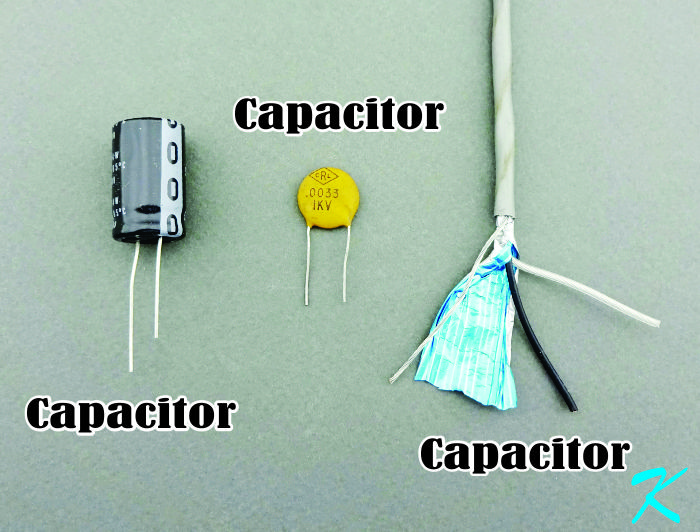It sounds like you have an inspector that has been burned by some other fire alarm installer who didn't pay attention to the capacitance of the wire. When the capacitance is too high, the Signaling Line Circuit (SLC) will have intermittent troubles, or may not even work at all.
There are specifications for the wire available from the wire's manufacturer. Sometimes this specification is even on reel or box that the wire came in.
The fire alarm control panel has the capacitance requirements shown in the installation manual itself. Often times, this specification is "less than 0.5 uf". If the manual isn't available, calling the technical support team will produce this information.
Keep in mind that, when they test to see if the fire alarm system actually works, UL, ULC, CE, FM, CCC, etc. has used the value shown in the installation manual. If they find that the fire alarm system works, the testing laboratory has placed the system, as tested, on their list of systems that work (that's what listing means).
Capacitance of the Wire

If a capacitor is two conductors separated by an insulator, then two wires inside a cable, each one insulated, makes up a capacitor. A shield increases this capacitance. I've made capacitors by twisting two insulated wires together, and then I measured the capacitance.
A capacitor is two conductors separated by an insulator. The capacitor may be an official capacitor like an electrolytic, ceramic, or tantalum capacitor, or it may be the fire alarm cable used for the SLC.
Every model of cable has a different capacitance per 1000 feet (or kilometer). Larger conductors have more surface area, so they have more capacitance. Thinner insulation around the conductors means the conductors are closer to each other, and there is more capacitance. The insulator material itself can and often does affect capacitance.
When the wire is longer, there is more capacitance. As far as capacitance goes, two t-tapped 50 foot (approximately 15 meter) lengths of cable has exactly the same capacitance as one 100 foot (approximately 30 meter) length of cable.
Capacitance is affected by the amount of wire, not by distance from the panel. If the wire has a capacitance of 0.5 uf at a length of 2000 feet, whether it's a single length of 2000 feet, or star-tapped at 10 lengths of 200 feet, it's still 2000 feet of wire, and it still has 0.5 uf of capacitance.
Shielding on the wire adds a HUGE amount of capacitance to a cable, so, many fire alarm manufacturers specify that shielded wire should not be used.
Capacitive Lag
The problem being addressed by keeping the wire below 0.5 uf of capacitance is "Capacitive Lag". Capacitive Lag is the length of time it takes to charge up the capacitance in the wire, and the length of time it takes to discharge the capacitance in a wire.
When the lag is too long, the ones and zeros in the data being sent by the panel or the devices may not be detected: the ones and zeros step on each other. Data gets garbled or entirely lost when the ones or zeros aren't always detected.
Why is Capacitive Lag a Problem?
Low current exasperates the capacitive lag problem. However, the SLC circuit's power supply has to be low current.
The devices on the circuit have to rapidly short out the SLC in order to send data back to the panel. If the SLC's power supply was high current, the devices would burn up when they shorted out the SLC power supply.
The stand-by backup battery has to last a full 24 hours. If the SLC drew a lot of current, the battery would have to be much bigger.
Because of the low current on the SLC, the small capacitance of 0.5 uf is the limit for the panel you're using.
Trying to Measure While Devices are Connected
The problem you are going to have when measuring the circuit is that every addressable device has capacitors. If the devices are connected to the SLC during the measurement of the wire's capacitance, the extra capacitors will just add their capacitance to the circuit; the circuit, with any devises connected, will fail the capacitance test.
LCR Meter
Yes, many hand-held multimeters can measure the SLC's capacitance. The inspector, however, wants some assurance that the measurement is properly made, and also, that the device being used for the measurement is calibrated (accurate). Hand held multimeters don't fit the bill.
LCR meters are the best measuring tool. LCR meters are available on the web, and they aren't that expensive.
Technician's Corner has received a number of questions because fire marshals have required the measurements. It appears that this measurement, using an LCR meter to measure capacitance on an SLC circuit, may be the norm in the future.
Get an LCR meter, and in the future, before hanging devices on the SLC, measure the circuit. Document that you measured it, and in the document, show the results of the measurement. Doing the measurement before hanging devices on the circuit just may save you a lot of time.
Douglas Krantz


